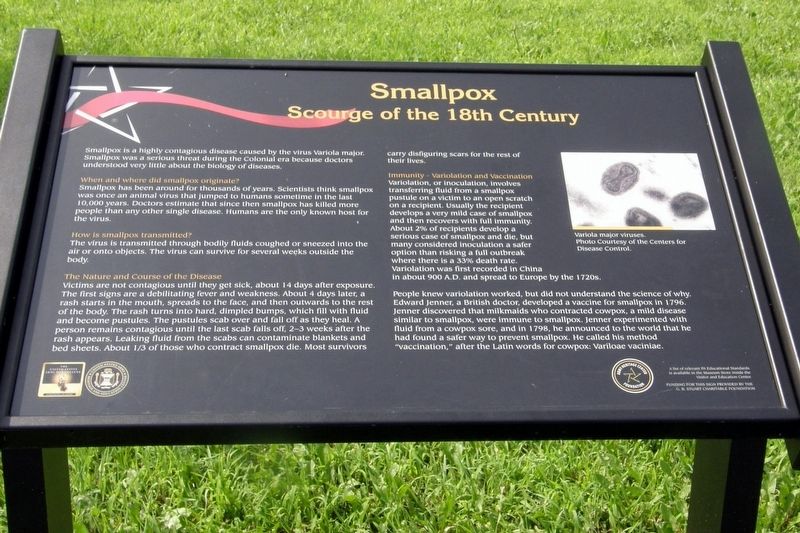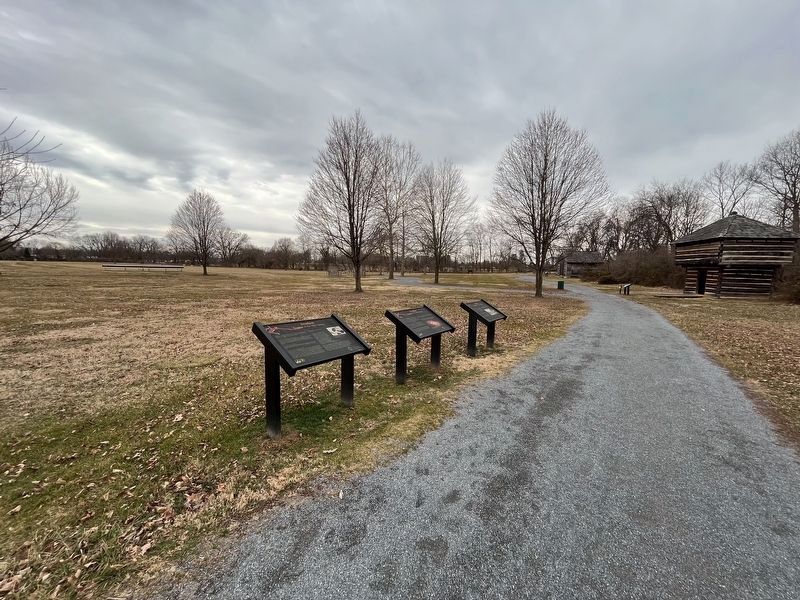Middlesex Township near Carlisle in Cumberland County, Pennsylvania — The American Northeast (Mid-Atlantic)
Smallpox
Scourge of the 18th Century
Smallpox is a highly contagious disease caused by the virus Varoila major. Smallpox was a very serious threat during the Colonial era because doctors understood very little about the biology of diseases.
When and where did smallpox originate?
Smallpox has been around for thousands of years. Scientists think smallpox was once an animal virus that jumped to humans sometime in the last 10,000 years. Doctors estimate that since then smallpox has killed more people than any other single disease. Humans are the only known host for the virus.
How is smallpox transmitted?
The virus is transmitted through bodily fluids coughed or sneezed into the air or onto objects. The virus can survive for several weeks outside the body.
The Nature and Course of the Disease
Victims are not contagious until they get sick, about 14 days after exposure. The first signs are a debilitating fever and weakness. About 4 days later, a rash starts in the mouth, spreads to the face, and then outwards to the rest of the body. The rash turns into hard, dimpled bumps, which fill with fluid and become pustules. The pustules scab over and fall off as they heal. A person remains contagious until the last scab falls off, 2-3 weeks after the rash appears. Leaking fluid from the scabs can contaminate blankets and bed sheets. About 1/3 of those who contact smallpox die. Most survivors carry disfiguring scars for the rest of their lives.
Immunity – Variolation and Vaccination
Variolation, or inoculation, involves transferring fluid from a smallpox pustule on a victim to an open scratch on a recipient. Usually the recipient develops a very mild case of smallpox and then recovers with full immunity. about 2% of recipients develop a serious case of smallpox and dies, but many considered inoculation a safe option than risking a full outbreak where there is a 33% death rate. Variolation was first recorded in China in about 900 A.D. and spread to Europe by the 1720s.
People knew variolation worked, but did not understand the science of why. Edward Jenner, a British doctor, developed a vaccine for smallpox in 1796. Jenner discovered that milkmaids who contracted cowpox, a mild disease similar to smallpox, were immune to smallpox. Jenner experimented with fluid from a cowpox sore, and in 1798, he announced to the world that he had found a safer way to prevent smallpox. He called his method “Vaccination”, after the Latin words for cowpox: Variloae Vaciniae.
A list of relevant PA Educational Standards is available in the Museum Store inside the Visitor and Education center. Funding for this sign provided by the G.B. Stuart Charitable Foundation.
Erected by
Topics. This historical marker is listed in these topic lists: Science & Medicine • War, US Revolutionary. A significant historical year for this entry is 1796.
Location. 40° 12.267′ N, 77° 9.495′ W. Marker is near Carlisle, Pennsylvania, in Cumberland County. It is in Middlesex Township. Marker can be reached from Army Heritage Drive. Touch for map. Marker is in this post office area: Carlisle PA 17013, United States of America. Touch for directions.
Other nearby markers. At least 8 other markers are within walking distance of this marker. A different marker also named Smallpox (here, next to this marker); a different marker also named Smallpox (here, next to this marker); Stations Upon The Road (a few steps from this marker); A Century of Protection (within shouting distance of this marker); Specialist Fourth Class Robert D. Law (within shouting distance of this marker); Lieutenant Colonel William Orlando Darby (within shouting distance of this marker); Technical History (within shouting distance of this marker); General Francis “Swamp Fox” Marion (within shouting distance of this marker). Touch for a list and map of all markers in Carlisle.
Credits. This page was last revised on March 2, 2023. It was originally submitted on June 22, 2017, by Larry Gertner of New York, New York. This page has been viewed 230 times since then and 13 times this year. Photos: 1. submitted on June 22, 2017, by Larry Gertner of New York, New York. 2. submitted on March 2, 2023, by Devry Becker Jones of Washington, District of Columbia. • Bill Pfingsten was the editor who published this page.

